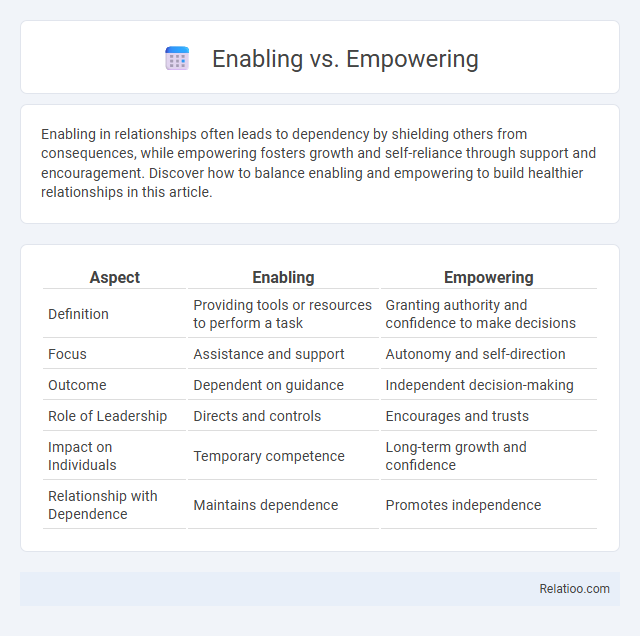Enabling in relationships often leads to dependency by shielding others from consequences, while empowering fosters growth and self-reliance through support and encouragement. Discover how to balance enabling and empowering to build healthier relationships in this article.
Table of Comparison
| Aspect | Enabling | Empowering |
|---|---|---|
| Definition | Providing tools or resources to perform a task | Granting authority and confidence to make decisions |
| Focus | Assistance and support | Autonomy and self-direction |
| Outcome | Dependent on guidance | Independent decision-making |
| Role of Leadership | Directs and controls | Encourages and trusts |
| Impact on Individuals | Temporary competence | Long-term growth and confidence |
| Relationship with Dependence | Maintains dependence | Promotes independence |
Understanding the Difference: Enabling vs Empowering
Enabling involves providing tools or resources that allow someone to perform tasks but may limit their autonomy or decision-making power, whereas empowering focuses on fostering independence, confidence, and the ability to take control of one's own actions and decisions. Your understanding of these distinctions is crucial for creating a support system that promotes genuine growth rather than dependency. A true empowering approach enhances personal capability, while enabling can unintentionally hinder long-term development by maintaining reliance.
The Psychology Behind Enabling and Empowering
The psychology behind enabling and empowering centers on how behaviors impact an individual's autonomy and growth, with enabling often fostering dependency by shielding people from consequences, while empowering encourages self-efficacy and resilience through promoting personal responsibility. Your support system plays a crucial role by either reinforcing enabling patterns or facilitating empowerment, directly affecting motivation and psychological well-being. Understanding these dynamics helps create healthier relationships that contribute to lasting positive change.
Key Traits of Enabling Behavior
Enabling behavior is characterized by unintentionally supporting harmful habits or dependency through excessive assistance or avoidance of consequences, often hindering personal growth and accountability. Key traits include overprotection, making excuses for negative actions, and preventing individuals from facing challenges needed for development. Understanding these traits helps you distinguish enabling from empowering or supportive behaviors that foster independence and resilience.
Core Characteristics of Empowering Actions
Empowering actions prioritize autonomy, capacity-building, and fostering self-efficacy, enabling individuals to take control and make informed decisions. Unlike enabling, which often involves doing tasks for others, empowerment focuses on equipping people with skills, resources, and confidence to act independently. Support systems provide assistance and encouragement, but empowering actions cultivate resilience and long-term growth through active participation and shared ownership.
Impacts of Enabling on Growth and Development
Enabling systems provide the essential resources and conditions that foster Your growth and development by removing barriers and facilitating access to opportunities. These systems create an environment where capabilities can be nurtured, leading to increased autonomy and confidence. The impact of enabling is foundational, driving sustainable progress by equipping individuals with the tools needed to achieve their full potential.
Benefits of Empowering Individuals or Teams
Empowering individuals or teams fosters greater autonomy, creativity, and accountability, driving higher motivation and performance. This approach enhances problem-solving skills and innovation by encouraging self-direction and decision-making. Empowered teams are more resilient and adaptable, contributing directly to organizational growth and success.
Enabling in the Workplace: Risks and Consequences
Enabling in the workplace often means allowing negative behaviors to persist, which can undermine team productivity and morale. Your tolerance of enabling actions may lead to unchecked poor performance, creating a culture of complacency and reducing accountability. Recognizing these risks is crucial to fostering a healthier, more effective work environment.
Empowerment Strategies for Leaders and Managers
Empowerment strategies for leaders and managers involve fostering autonomy, encouraging decision-making, and promoting skill development to enhance employee confidence and performance. Unlike enabling, which may create dependency, empowerment cultivates accountability and innovation by providing the resources and authority your team needs to succeed. Support systems complement empowerment by offering guidance and tools, but true leadership impact comes from empowering employees to take ownership of their roles.
Transforming Enabling Behaviors into Empowering Practices
Transforming enabling behaviors into empowering practices involves shifting from providing excessive assistance to fostering autonomy and self-efficacy. Enabling systems often create dependency by doing tasks for others, whereas empowering practices build skills, confidence, and decision-making abilities. A support system that emphasizes empowerment encourages growth by setting boundaries, promoting accountability, and facilitating access to resources for sustainable personal development.
Real-World Examples: Enabling vs Empowering Dynamics
Enabling often involves providing tools or resources that allow someone to perform a task, such as a manager giving employees access to software needed for data analysis. Empowering goes further by fostering confidence and decision-making autonomy, exemplified by a team leader encouraging members to set their own goals and make strategic choices. Your support system may combine both dynamics by offering practical assistance while nurturing independence and growth in real-world settings.

Infographic: Enabling vs Empowering
 relatioo.com
relatioo.com